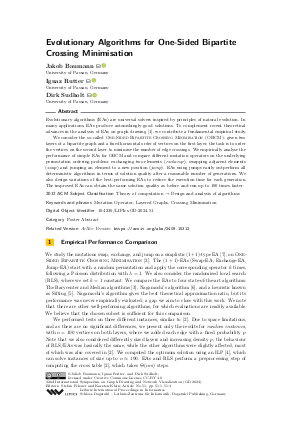Evolutionary Algorithms for One-Sided Bipartite Crossing Minimisation (Poster Abstract)
Authors
Jakob Baumann  ,
Ignaz Rutter
,
Ignaz Rutter  ,
Dirk Sudholt
,
Dirk Sudholt 
-
Part of:
Volume:
32nd International Symposium on Graph Drawing and Network Visualization (GD 2024)
Part of: Series: Leibniz International Proceedings in Informatics (LIPIcs)
Part of: Conference: Graph Drawing and Network Visualization (GD) - License:
 Creative Commons Attribution 4.0 International license
Creative Commons Attribution 4.0 International license
- Publication Date: 2024-10-28
File

PDF
LIPIcs.GD.2024.51.pdf
- Filesize: 0.57 MB
- 3 pages
Document Identifiers
Related Versions
- ArXiv Version https://arxiv.org/abs/2409.15312
Subject Classification
ACM Subject Classification
- Theory of computation → Design and analysis of algorithms
Keywords
- Mutation Operator
- Layered Graphs
- Crossing Minimisation
Metrics
- Access Statistics
-
Total Accesses (updated on a weekly basis)
0PDF Downloads0Metadata Views
Abstract
Evolutionary algorithms (EAs) are universal solvers inspired by principles of natural evolution. In many applications, EAs produce astonishingly good solutions. To complement recent theoretical advances in the analysis of EAs on graph drawing [Baumann et al., 2024], we contribute a fundamental empirical study. We consider the so-called One-Sided Bipartite Crossing Minimisation (OBCM): given two layers of a bipartite graph and a fixed horizontal order of vertices on the first layer, the task is to order the vertices on the second layer to minimise the number of edge crossings. We empirically analyse the performance of simple EAs for OBCM and compare different mutation operators on the underlying permutation ordering problem: exchanging two elements (exchange), swapping adjacent elements (swap) and jumping an element to a new position (jump). EAs using jumps easily outperform all deterministic algorithms in terms of solution quality after a reasonable number of generations. We also design variations of the best-performing EAs to reduce the execution time for each generation. The improved EAs can obtain the same solution quality as before and run up to 100 times faster.
Cite As Get BibTex
Jakob Baumann, Ignaz Rutter, and Dirk Sudholt. Evolutionary Algorithms for One-Sided Bipartite Crossing Minimisation (Poster Abstract). In 32nd International Symposium on Graph Drawing and Network Visualization (GD 2024). Leibniz International Proceedings in Informatics (LIPIcs), Volume 320, pp. 51:1-51:3, Schloss Dagstuhl – Leibniz-Zentrum für Informatik (2024)
https://doi.org/10.4230/LIPIcs.GD.2024.51
BibTex
@InProceedings{baumann_et_al:LIPIcs.GD.2024.51,
author = {Baumann, Jakob and Rutter, Ignaz and Sudholt, Dirk},
title = {{Evolutionary Algorithms for One-Sided Bipartite Crossing Minimisation}},
booktitle = {32nd International Symposium on Graph Drawing and Network Visualization (GD 2024)},
pages = {51:1--51:3},
series = {Leibniz International Proceedings in Informatics (LIPIcs)},
ISBN = {978-3-95977-343-0},
ISSN = {1868-8969},
year = {2024},
volume = {320},
editor = {Felsner, Stefan and Klein, Karsten},
publisher = {Schloss Dagstuhl -- Leibniz-Zentrum f{\"u}r Informatik},
address = {Dagstuhl, Germany},
URL = {https://drops.dagstuhl.de/entities/document/10.4230/LIPIcs.GD.2024.51},
URN = {urn:nbn:de:0030-drops-213353},
doi = {10.4230/LIPIcs.GD.2024.51},
annote = {Keywords: Mutation Operator, Layered Graphs, Crossing Minimisation}
}
Author Details
References
- Jakob Baumann, Ignaz Rutter, and Dirk Sudholt. Evolutionary computation meets graph drawing: Runtime analysis for crossing minimisation on layered graph drawings. In Xiaodong Li and Julia Handl, editors, Proceedings of the Genetic and Evolutionary Computation Conference, GECCO 2024, Melbourne, VIC, Australia, July 14-18, 2024. ACM, 2024. To appear. URL: https://doi.org/10.1145/3638529.3654105.
- Camil Demetrescu and Irene Finocchi. Removing cycles for minimizing crossings. ACM J. Exp. Algorithmics, 6:2-es, 2001. URL: https://doi.org/10.1145/945394.945396.
- Peter Eades and Nicholas C. Wormald. Edge crossings in drawings of bipartite graphs. Algorithmica, 11(4):379-403, 1994. URL: https://doi.org/10.1007/BF01187020.
- Michael Jünger and Petra Mutzel. 2-layer straightline crossing minimization: Performance of exact and heuristic algorithms. J. Graph Algorithms Appl., 1(1):1-25, 1997. URL: https://doi.org/10.7155/jgaa.00001.
- Christian Matuszewski, Robby Schönfeld, and Paul Molitor. Using sifting for k-layer straightline crossing minimization. In Graph Drawing, 7th International Symposium, GD'99, Stirín Castle, Czech Republic, September 1999, Proceedings, pages 217-224. Springer, Springer, 1999. URL: https://doi.org/10.1007/3-540-46648-7_22.
- Hiroshi Nagamochi. An improved bound on the one-sided minimum crossing number in two-layered drawings. Discrete & Computational Geometry, 33:569-591, 2005. URL: https://doi.org/10.1007/s00454-005-1168-0.
- Pietro S. Oliveto, Jun He, and Xin Yao. Time complexity of evolutionary algorithms for combinatorial optimization: A decade of results. International Journal of Automation and Computing, 4(3):281-293, 2007. URL: https://doi.org/10.1007/S11633-007-0281-3.
-
Frank Wilcoxon. Individual comparisons by ranking methods. Biometrics Bulletin, 1(6):80-83, 1945.

